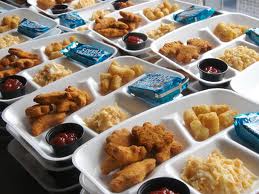 On
any single day, an overweight teenage boy lines up in the school cafeteria to
receive his school lunch.
On
any single day, an overweight teenage boy lines up in the school cafeteria to
receive his school lunch.
If this student attends an inner-city school, odds are the government subsidizes his lunch by making it completely free or at a reduced cost. Thanks to Uncle Sam he won't go hungry, but odds are he'll get unhealthy.
According to a 2009 article in USA Today, nearly 20 million children receive free lunch in our nation's schools. As the number of children receiving lunch grows to an all-time high, many school districts struggle to cover the costs.
Their typical menu may consist of hot dogs, pizza and other high calorie and high fat foods. The logic: cheap food feeds a growing number of children needing free lunch.
At night, his mother may buy him dinner from the nearby McDonald's. She really wants her son to eat healthier, but she, an overworked and exhausted single mother, has to choose her priorities.
 This
is the story of millions of teenagers living in depressed, urban communities.
They contribute to a growing epidemic of obesity in America -- the fattest
nation in the world.
This
is the story of millions of teenagers living in depressed, urban communities.
They contribute to a growing epidemic of obesity in America -- the fattest
nation in the world.
Nutritious
foods out-price many, making it more difficult for families to eat healthy
foods in America. As such, the Center for Disease Control says diabetes rates
will go up by 50 percent in the next few decades.
"I would like to eat healthier, but we keep being fed food high in fat and sodium," said 7th grader Alex Gomez of Hialeah, Florida.
Adding fuel to the fire, the strain of the recession, rates of depression, anxiety and stress, which are linked to obesity for many individuals, are also increasing.
Fortunately, activists like Lisa Sharon Harper, Executive Director of non-profit group NY Faith and Justice, are aware of these links and are dead set on making sure there's change.
"If the
government could help farmers subsidize fruits and vegetables instead of
products high in sugar, soy, and corn, we could see a substantial difference in
health," said Harper, who spearheaded the Food, Faith and Health
Disparities Summit in New York City.
LOOKING BEYOND DIETS
 On
October 29-30, the Food, Faith and Health Disparities Summit suggested that we
take a look beyond the surface and into some solutions for curing America's
obsession with bad food.
On
October 29-30, the Food, Faith and Health Disparities Summit suggested that we
take a look beyond the surface and into some solutions for curing America's
obsession with bad food.
How
can we put a stop to the current trends that say that our
children/grandchildren will have shorter life spans because of countless
nutrition-related diseases?
What is the average person to do when there are more fast food restaurants in cities like New York than there are fresh fruits and vegetables?
The
summit attempted to find the answers to these tough questions.
First off. It
gave attendees a brief history lesson.
In 1740, The
South Carolina Slave Code sought to gain greater control over enslaved Africans
by prohibiting them from gathering food without white supervision, from
learning to read and write, and from growing their own food.
Fast forward more than 200 years later. The damage caused by such slave codes is still evident in inner cities such as New York where healthy foods are not easily accessible to people living in disenfranchised communities.
According to a
study conducted by the New York City Department of Health, children in Central
and East Harlem are the highest growing population for type two diabetes; this
is partly due to the fact that most food sources in this area offer very few
fresh food options.
 Most people rely
on fast food chains and "bodegas," a spanish language adapted term
for NYC corner convenience stores.
Most people rely
on fast food chains and "bodegas," a spanish language adapted term
for NYC corner convenience stores.
"Bodegas" don't have the kind of
refrigeration required to store fresh fruits and vegetables and fast food
restaurants offer processed foods high in fat, sodium, and sugar. What's more,
Central and East Harlem are not alone.
Children from ages
0-4 years old in Central Brooklyn and the South Bronx are 2.8 times more likely
to experience a hospitalization from type two diabetes in their lifetimes than
their counterparts in more affluent areas of New York City like Tribeca and the
Upper West Side. Sadly, they are 2.3 times more likely to die from the disease.
FIGHTING FOOD DESERTS
 "People
might want to eat healthy. However, without proper access to healthy food, they
are limited," said Harper.
"People
might want to eat healthy. However, without proper access to healthy food, they
are limited," said Harper.
Dr. Nicholas Freudenberg, Distinguished Professor of Public Health at CUNY - School of Public Health at Hunter College, claims that many New Yorkers live within communities labeled "food deserts," a district with little or no access to foods needed to maintain a healthy diet but often served by plenty of fast food restaurants.
So while McDonald's, Burger King and fried chicken joints may abound in high concentration in this urban center, New York City has one-third less supermarkets than it did six years ago.
"Processed foods cost less than fruits and grains," said Freudenberg, one of the first speakers at the summit's Friday kick-off. "Cities like New York and London are similar in this way. In communities throughout New York City, there is a food justice movement, however."
This movement says that one's income or zip code should not determine whether we can eat good, healthy foods.

Organizations
like We Act, a northern Manhattan non-profit organization for environmental
justice, is working to create ready availability of produce,
dairy, meats, legumes, nuts, grains and seeds that are fresh, unprocessed,
healthy, local and small-scaled when possible as well as to educate low-income
communities like Harlem on food
knowledge.
At the summit, Freudenberg told audiences the story of Belo Hortizonte, Brazil, located in the southeastern region of Brazil, where at one point 20 percent of its children were going hungry.
When the new mayor of the city, Patrus Ananias, made food a citizen's right in 1993, the farmer's healthier products were subsidized to promote fresh food production. Five years later, infant mortality rates dropped by half and it just cost the city two percent of its annual budget.
Thus, as America struggles to improve student performance in public schools and catch up to other leading nations, it begs the question: how much are our food systems having an impact on our nation's youth?
 In
1997, Appleton Central Alternative School (ACAS) in Wisconsin decided to test
the food theory.
In
1997, Appleton Central Alternative School (ACAS) in Wisconsin decided to test
the food theory.
An
alternative public high school for young people at higher risk of dropping out
or getting into trouble underwent the test. Appleton was experiencing an
epidemic of disruptive student behavior. It took up bread company Natural
Oven's no-strings offer to provide free, fruit-based natural energy drinks and
whole grain bagels for their student body to start the day.
Previously, students had binged on caffeinated soda, candy, and toaster pastries to get a morning energy boost.
In
time, student performance changed dramatically.
Each year principals in the state of Wisconsin are required to report the number of drop outs, expulsions, suicides, and students caught with weapons and using drugs. Since the start of the program, the school's numbers in every category have been "zero."
Thus, with the partnerships of corporations like Natural Ovens, parents, and the government, students may very well be able to beat the stereotypes applied to those living in food deserts.
And, with more access to the alternatives, perhaps dollar cheeseburgers and bright-colored vending machines will cease to be our community's default option.

